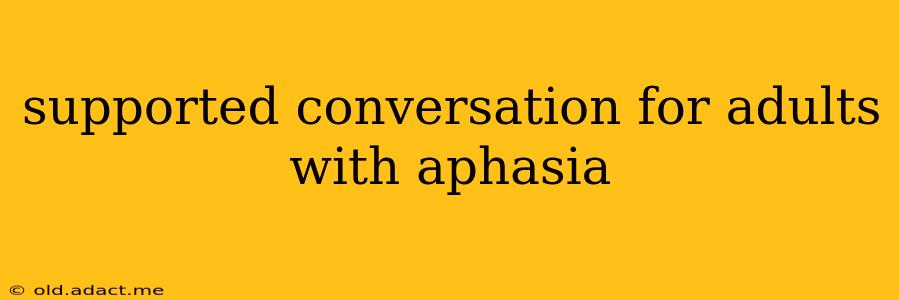Aphasia, a language disorder affecting the ability to communicate, can significantly impact daily life for adults. However, with the right support and strategies, individuals with aphasia can experience improved communication and a richer quality of life. This guide explores various techniques for supporting conversations with adults who have aphasia. Understanding the nuances of aphasia is crucial for fostering meaningful interactions and building strong relationships.
What is Aphasia?
Before delving into conversation strategies, it's essential to understand what aphasia entails. Aphasia is not a cognitive impairment; it's a language disorder resulting from damage to the brain, often caused by stroke. It affects different aspects of language, including speaking, understanding, reading, and writing. The severity and specific challenges vary widely depending on the location and extent of brain damage. Some individuals might struggle primarily with finding words (anomia), while others may have difficulty forming grammatically correct sentences (agrammatism). Understanding these variations is key to adapting your communication style.
How Can I Make Conversations Easier for Someone with Aphasia?
This is a frequently asked question, and the answer lies in adapting your communication approach. Here are some key strategies:
1. Speak Clearly and Slowly:
Don't rush the conversation. Speak clearly, using shorter sentences and simpler vocabulary. Avoid jargon or overly complex language. A slower pace gives the individual time to process information.
2. Use Visual Aids:
Pictures, gestures, and written words can significantly enhance comprehension. For example, if you're discussing a meal, showing a picture of the food can be more effective than just verbally describing it.
3. Be Patient and Empathetic:
Frustration and embarrassment are common experiences for individuals with aphasia. Be patient, allowing ample time for responses. Avoid interrupting and show understanding if communication is challenging.
4. Use Nonverbal Communication:
Body language plays a significant role in communication. Maintain eye contact, use gestures, and express warmth through your demeanor. These nonverbal cues can enhance understanding and create a more comfortable atmosphere.
5. Ask Yes/No Questions or Use Choice Boards:
When asking questions, simplify them to require only "yes" or "no" answers. Alternatively, utilize choice boards presenting several options for the individual to choose from. This limits the cognitive load and facilitates easier response.
6. Focus on Meaning, Not Perfection:
Don't get caught up in grammatical perfection. Concentrate on understanding the intended message, even if the phrasing isn't flawless. Encourage the individual to communicate, even if it's just a few words or gestures.
7. Give the Person Time to Respond:
Silence is not always a sign of lack of understanding. Give the individual adequate time to formulate their thoughts and responses. A prolonged pause doesn't equate to inability; it simply reflects the challenges posed by aphasia.
8. Encourage Participation and Engagement:
Create opportunities for the individual to participate actively in conversations, even if it's just nodding or pointing. Encourage their involvement and celebrate their communication attempts, no matter how small.
What Types of Activities Can Support Conversation?
Engaging in activities that stimulate language and communication can greatly benefit individuals with aphasia. These activities should be adapted to the individual's abilities and interests:
1. Storytelling and Reminiscing:
Sharing personal stories and reminiscing about past events can encourage verbal expression and memory recall. Using photos or objects as prompts can facilitate the process.
2. Singing and Music Therapy:
Music often bypasses some of the damaged language pathways in the brain. Singing familiar songs can stimulate language production and emotional expression.
3. Reading and Writing:
Reading aloud or writing simple sentences can aid in improving language comprehension and expression. Start with simple materials and gradually increase the complexity.
4. Games and Puzzles:
Interactive games like word association, picture matching, or simple board games can provide engaging opportunities for communication and interaction.
5. Communication Apps and Technology:
Numerous apps and communication devices are designed to help people with aphasia express themselves. These tools can provide alternative modes of communication, such as text-to-speech or picture exchange systems.
What are Some Communication Strategies that DON'T Work Well?
1. Finishing their sentences:
While it seems helpful, interrupting and finishing sentences can be detrimental. It prevents the individual from practicing and developing their own communication skills.
2. Talking Down to Them:
Maintaining respect and treating the individual as an adult is paramount. Avoid condescending or patronizing language.
3. Pressuring for Perfect Communication:
Don't force or pressure the individual to communicate perfectly. Focus on mutual understanding and comfortable interaction.
4. Ignoring Attempts to Communicate:
Even if communication is challenging, acknowledge and encourage any attempt at verbal or nonverbal communication.
By embracing these strategies and fostering a supportive environment, you can significantly improve communication with adults with aphasia, helping them regain their voice and actively participate in meaningful conversations. Remember, patience, empathy, and a willingness to adapt are essential components in supporting effective communication for all.
